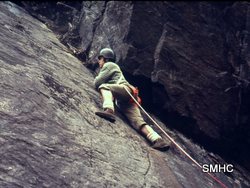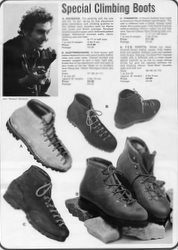
The Scottish Mountain Heritage Collection
Objects Database
Kletterschuhe (Climbing Shoes)
Accession Number
622.2008.1
Object Name
Kletterschuhe (Climbing Shoes)
Created
08/12/2008
Creator
Hermione Cooper
Accession Date
08/12/2008
Brief Description
Kletts - early walking/climbing shoes. Brown suede shoes with metal eyeholes and black laces and white laces. Rubber soles.
Materials
suede, rubber, cotton
Dimensions
28(l) x 9.5(w) cms. 29(L) x11(W) cms
Number Of Objects
2 pairs
Inscription Description
On sole a circle with an "S" inside and the inscription "INNSBRUCKER KLETTER SUPER" written below.
On sole of other pair "KLETTER SHOER"
Colour
brown
Maker
Kletter
Object Production Place
Austria
Provenance
Rock climbers used various types of footwear in the early days to help with friction. In the 1930’s French and Italian climbers used ‘espadrilles’ which are a rope soled shoe; Scottish climbers famously wore ’gutties’ which were basically plimsoles often bought from the now defunct Woolworth stores; the Germans had their ‘kletterschuhe’, two pairs of which we have here in the collection.
Our founder, Mick Tighe, had a pair of kletterschuhe in the 1970’s and found them pretty lethal.
Fortunately, Edouard Bordonneau, a Frenchman, perfected a smooth soled boot for rock climbing in the 1940’s which had first been created by another Frenchman, Pierre Allain. Using one or the other of these guys initials, rock boots 60 years later are still collectively known as PA’s or EB’s, though rather confusingly one of the UK’s leading outdoor retailers is called Ellis Brigham ..a different EB.
The EB/PA has been reproduced in myriad forms over the decades with kletterschuhe consigned to the heritage collections ...probably the best place for them!
Acquisition Date
08/12/2008
Condition Check Date
28/04/2009
Rules
Spectrum : UK Museum documentation standard, V.3.1 2007
Modified
28/04/2009


